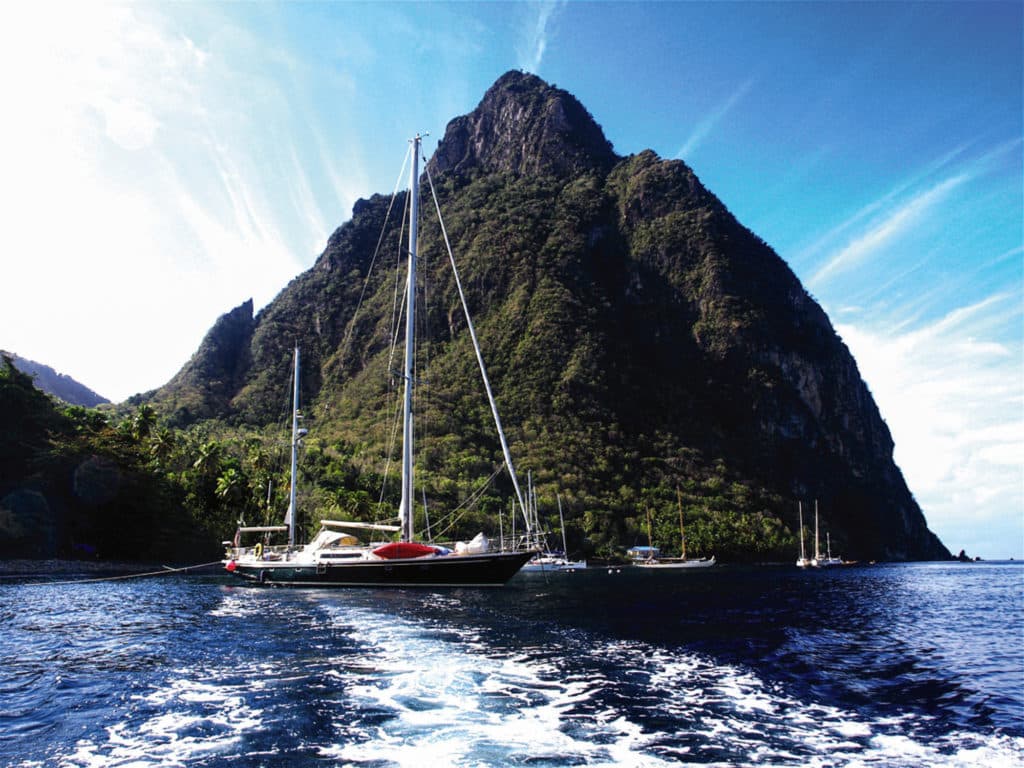
My friend Larry Tyler and I have known each other and sailed the Caribbean together for years. Larry has been chartering The Dove, his 54-foot Bill Crealock-designed yacht, in the islands for 30 seasons. So he was the natural person to ask perhaps a not-so-simple question: What are your favorite places to drop the hook in the Caribbean?
“What criteria do we use?” he wondered. “What defines a desirable anchorage?”
“I want clear water for swimming, and to see the sunset each evening,” I said.
He took that simple yardstick and ran with it. “It must be unspoiled, a near-empty place,” he added. “With good holding ground and access ashore. My charter guests want it calm, with no swell. A nice local or French restaurant ashore is always a must. Certainly, no bugs and good snorkeling.”
“A small village with a farmers market, and trails for hiking ,” I countered. With these conditions in mind, we set about drawing up our lists. Mine included three coves in the British Virgin Islands. Larry began in Anguilla. We both ended up in Grenada, at the southern end of the chain.
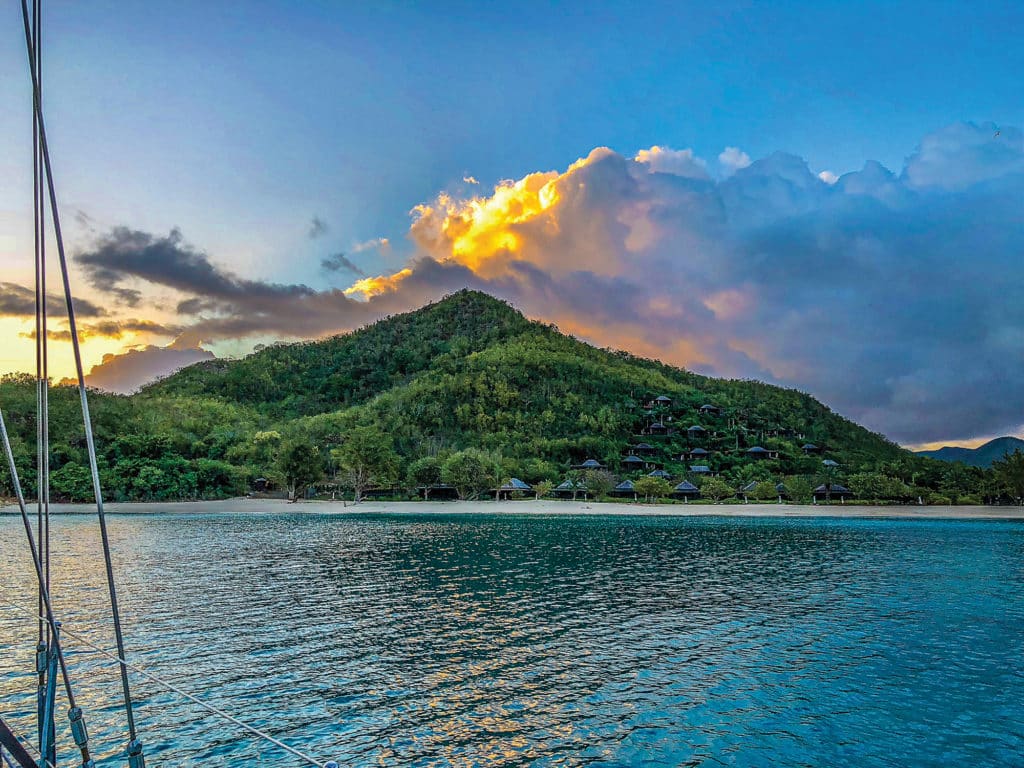
“Anse Colombier on St. Barts is my ideal,” Larry said. “No roads, no houses, no bars, no restaurants, a great beach and hiking trails. And the town Gustavia, with a patisserie, is a 2-mile dinghy ride away.”
“Five Island Bay and English Harbor on Antigua are my favorites,” I replied. Then again, there’s Deshaies and Les Saints on Guadeloupe, and Saint-Pierre and Sainte-Anne on Martinique. Choices, choices! We both agreed that the anchorage beneath the Pitons on St. Lucia is memorable. I liked Bequia, though Larry insisted it’s getting too popular. He preferred Cumberland Bay on St. Vincent and Chatham Bay on Union Island (where he and his mate, Justina, spent much of last year during lockdown).
I must say, I could spend a month in any one of these anchorages. But when push came to shove, Larry and I jotted down our notes on eight great, specific Caribbean anchorages. You can’t go wrong with any of them.
Five Island Bay, Antigua
Larry and I sailed The Dove into Five Island Bay late one night in November 2019—the conclusion to a three-week delivery from Maine. When I awoke the next morning, the sun was peeking over a series of small hills that encircles this large, open bay. We were the only boat anchored in paradise.
If you get in close enough to the exclusive Hermitage Resort, you might pick up its free Wi-Fi. Evenings, the jazz singer at the resort will lull you to sleep, then it goes quiet by 10 p.m. Half a dozen coves and beaches encircle the bay, but few boats anchor there. I’ve never seen more than five at a given time.
There, then, is solitude. But a mere 12-minute dinghy ride brings you into Jolly Harbor, an extensive marine complex that’s more Fort Lauderdale than Caribbean. There’s a marina there, a boatyard, fuel dock, restaurants, and the best supermarket on the island. There are rental cars, a marine chandlery and a pharmacy, and you can clear in and out there. Pretty much all the bases are covered.
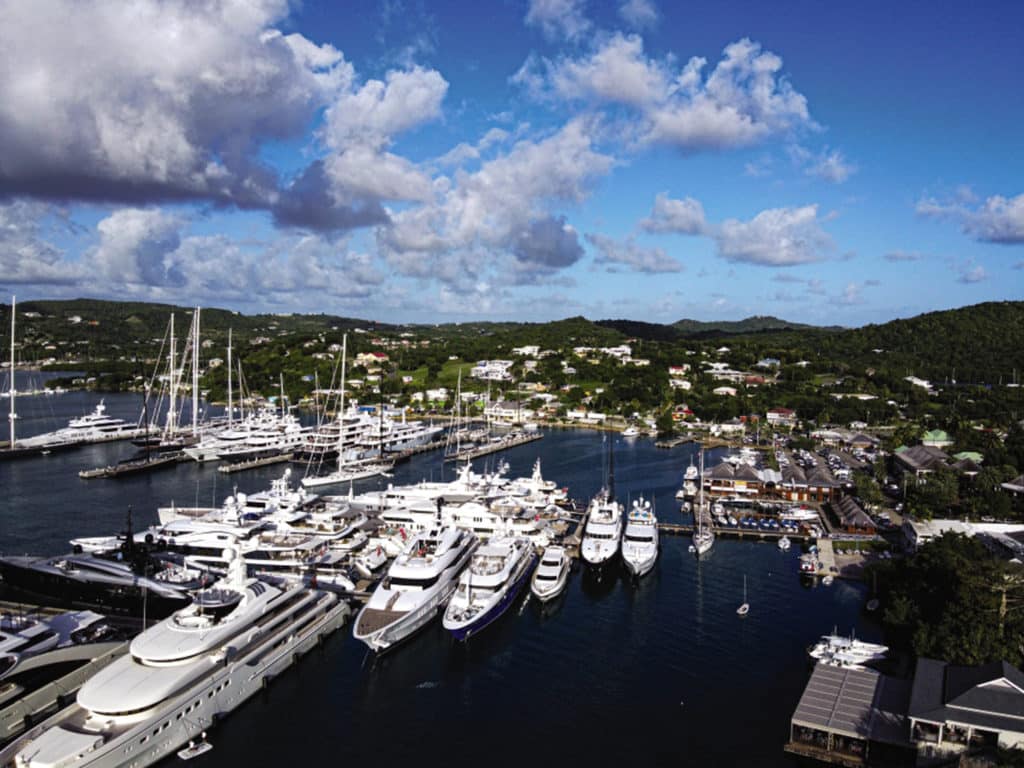
English Harbour, Antigua
There’s only so much solitude a sailor can take before needing to get back to civilization. An hour away from Five Islands is one of sailing’s great meccas: Falmouth and English harbours. That fall, before the pandemic hit, we anchored The Dove off Pigeon Beach. Falmouth is a large harbor with lots of room. Most everything you need can be found in the village of English Harbour: fuel and water, a chandlery, a sailmaker, a repair yard. A lone farmer has his stand by the dinghy dock; the laundry is directly across the street. The Seabreeze Cafe, next to the Yacht Club, has Wi-Fi, and restaurants abound in this village devoted to sailing.
Huge mega-yachts, liveaboard cruising boats, dinghies, bareboat charter yachts, paddleboarders, and everything else that floats come and go all day long. There’s always something going on there: the Charter Yacht Show, the Classic Yacht Regatta, Antigua Sailing Week, a lone rower paddling in having just crossed the Atlantic. As I said: whatever floats.
It’s a short walk to Nelson’s Dockyard and a step back into the 1700s. This restored British naval base has a museum, bakery, rum locker and the famous Admiral’s Inn. Yachts are docked stern to, with more riding at anchor out in Freeman Bay. Heading up to Shirley’s Heights for the sunset ritual—a rum punch, a steel band and a view—is well worth the 30-minute hike.
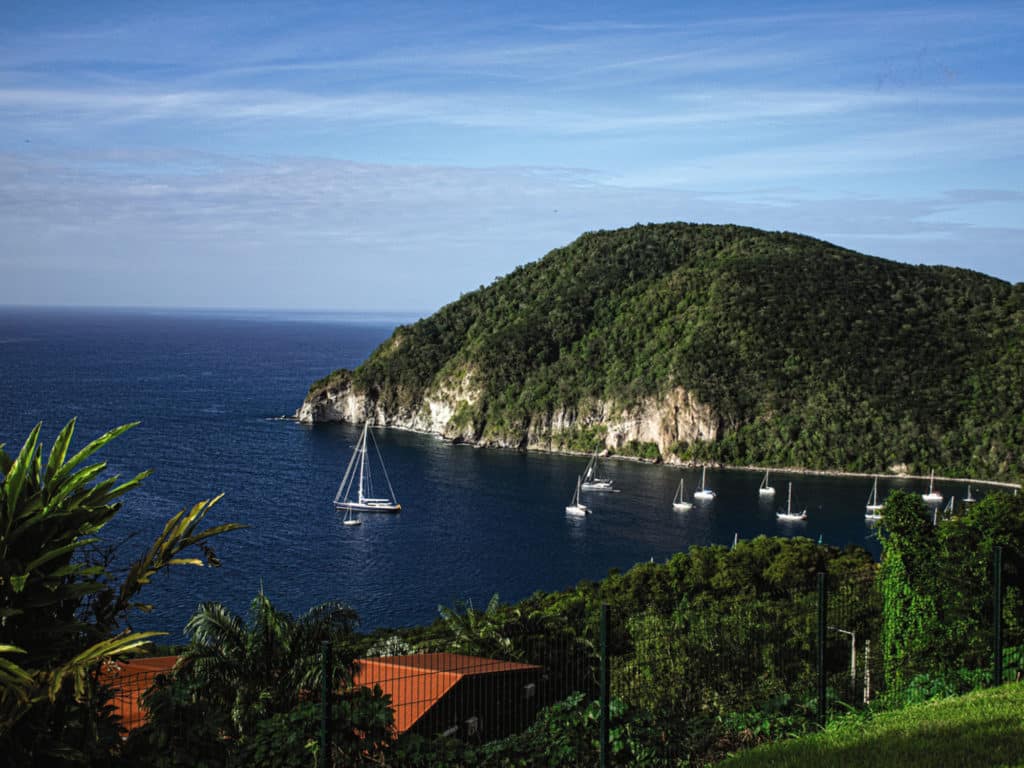
Deshaies, Guadeloupe
It’s 48 nautical miles of open-ocean sailing from Antigua across the waters to the lee of Guadeloupe and Deshaies, a small harbor tucked in between two tall cliffs. I could spend weeks there—and in fact, I have. It’s there you clear into France. The customs and immigration “office” is a computer inside La Pelican Boutique. This small, one-street village is not on the cruise-ship ports or the tourists’ bus excursions. It’s a residential town with three small groceries stores and the best tomatoes and pineapples I’ve tasted. The patisserie opposite the dingy dock has fresh croissants and baguettes every morning (though your coffee comes out of a coin-operated machine). There are a few boutiques, an ATM, three dive operators, and rental cars, but no yacht services or supplies. Wi-Fi is available at Le Madras, a thatched-roof cafe right on the beach.
Just around the corner is a mile-long sandy beach. Take the dinghy around and anchor outside the break, or walk over on marked trails, around or up over the cliff. An hour south is the Cousteau Underwater Park, ideal for snorkeling and scuba diving. A hiking trail follows a stream that runs down from the mountains, tumbling over boulders and splashing into pools just right for a swim. A mile south of the village is an extensive botanical garden park. My family and I spent half a day there last year.
The holding ground in the harbor at Deshaies is not great, so make sure your anchor is well-set. The wind can occasionally come blasting through the mountain valleys. An East Coast storm will send swells into Deshaies, and conditions will become uncomfortable and dangerous. I recently had to up-anchor and escape those swells. It must be said: Paradise often comes with her blemishes.
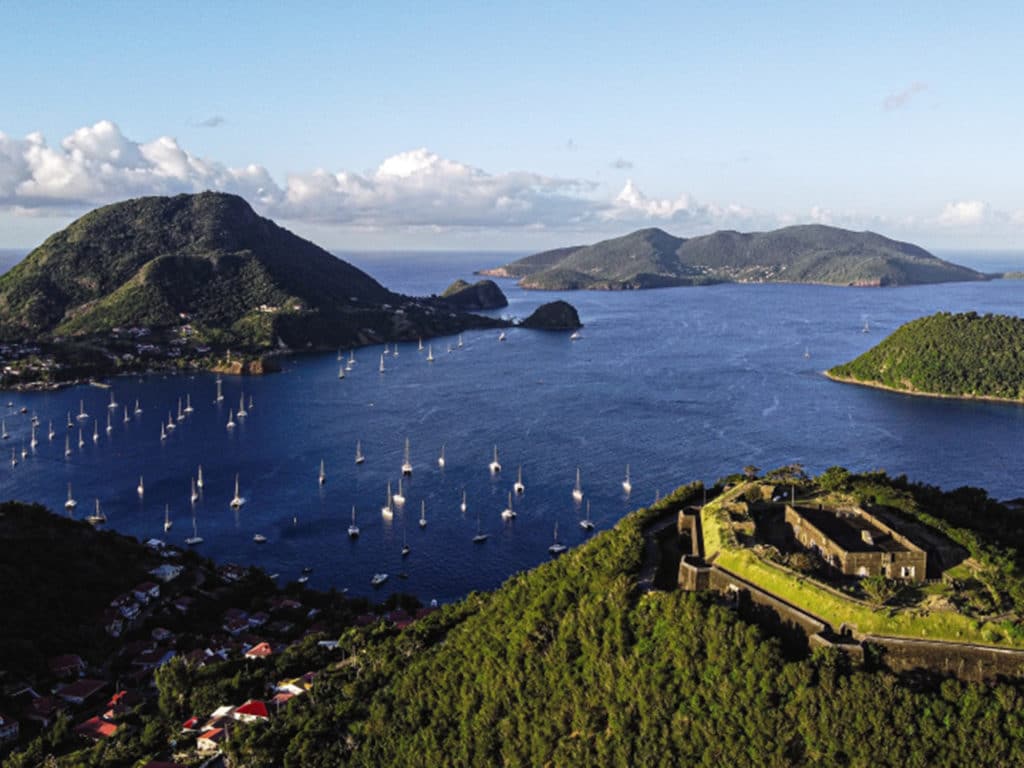
South of Guadeloupe: Les Saintes
Les Saintes is a cluster of small islands with a single village, 6 miles south of Guadeloupe. Last year, we found a vacant anchorage between Tête Rouge and Pain de Sucre, in 30 feet of clear water. There are other anchorages among these isles, but the closer into the village of Bourg des Saintes, the more crowded it becomes. Our solitude meant a 10-minute dinghy ride into town—nothing too onerous. Ashore, the village hadn’t changed since I was there 20 years prior.
Here’s Larry’s take: “Mornings, we sit at a bakery on the beach with coffee and croissants, watching the village wake up. On my last visit, French schoolchildren, in uniforms, scampered past as shopkeepers swept the pavement in front of their stores, their colorful fabrics and local artworks spilling onto the sidewalks. We had the entire village to ourselves. Then, the first of a dozen ferry boats arrived at the town pier to disgorge hundreds of tourists from the mainland. The village was now abuzz, the single street packed. There are electric mopeds and bikes to rent, restaurants galore from which to choose, roads and paths to walk, beaches to visit. Fort Napoleon is a short hike away. But we had to mind those daredevil motocross kids as they zipped past!
“The crowd quickly thinned out, heading to the beaches to the south and east. This went on all morning, with the reverse in the afternoon. By tea time, we again had the place to ourselves.”
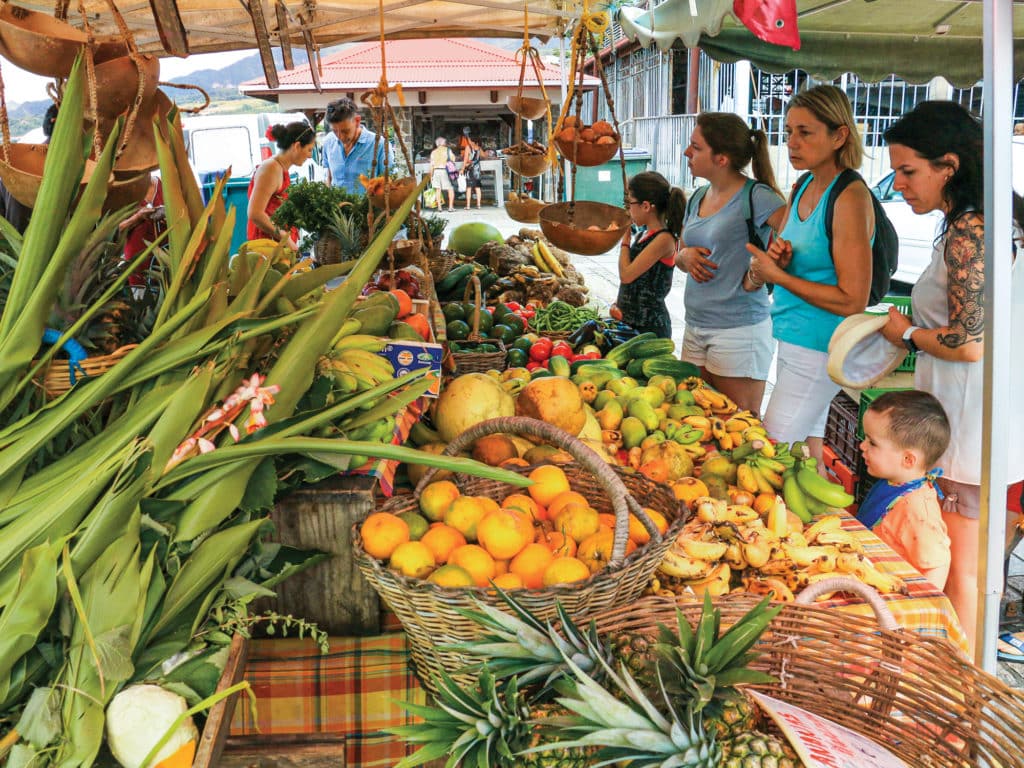
Sainte-Pierre, Martinique
It’s 70 nautical miles from Les Saintes down to Sainte-Pierre on Martinique. In other words, it’s an all-day sail with strong winds and higher seas between the islands. That said, you can stop midway for a few days of respite in the town of Portsmouth, on Dominica.
On our last visit to Sainte-Pierre, we furled the sails and motored into the open roadstead along the port’s narrow beach. The only suitable anchorage is a narrow shelf that extends less than 500 feet from shore. Depths fall off quickly to 1,000 feet. If you can’t find a spot there, try a bit farther south, under the monument. Ashore, we found the restaurant we dined at 10 years ago, and the family tucked in for dinner. This town is extremely French and not touristy.
We rented a car and drove into the mountains to explore. We found a deserted and overgrown turnoff. The kids scampered down the slope to a cascading stream, and my wife, Julie, and I followed. There, we found small waterfalls, deep pools, smooth boulders, and spillways. We spent two hours slipping and sliding, swimming and floating in the cool pools. No one else was around.
Sainte-Pierre has a volcanic history, and there’s a museum to visit; the streets are lined with shops; and a large open market next to the dinghy dock has fresh local fruits and veggies. We filled our basket.
The cultural and economic differences between the French islands and their other Caribbean counterparts is striking. Guadeloupe and Martinique are large isles, with modern infrastructure, excellent highways and real cities. You could be on the Cote d’Azur. By contrast, while the former English colonies were left to fend for themselves, the country of France still holds claim to their islands, and spends lavishly on their tropical offspring…to the lament of the French people stuck back home.
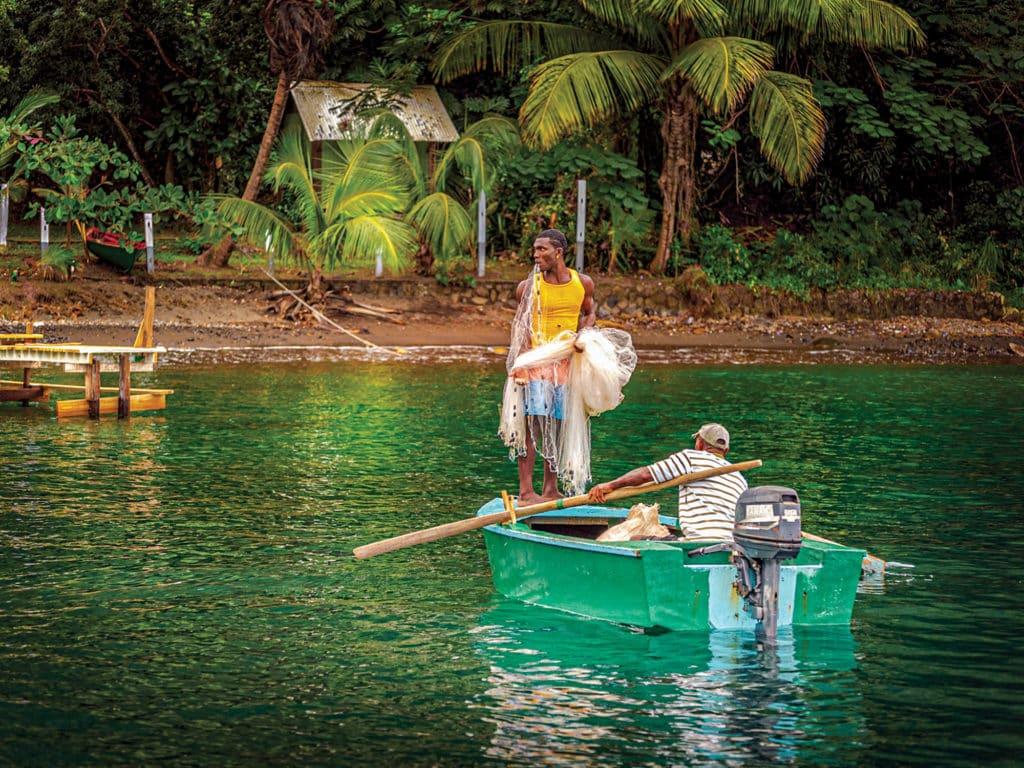
Cumberland Bay, St. Vincent
Halfway down the west coast of St. Vincent is a small cove, Cumberland Bay. “This is my favorite anchorage,” said Larry’s mate, Justine. “It’s the real Caribbean. You can smell the jungle.”
“There are no tourists, no cruise ships, and room for just a few boats,” Larry seconded. “You have to tie off astern to a coconut tree on the beach. There are no streets, stores or shops, but there are a few barbecue shacks and restaurants on the beach. The fishermen there are very nice, and they are eager to meet you and talk—and of course, sell you fish! You can buy bananas, coconuts and vegetables from local farmers, and some of the men will organize a pig roast for you, right on the beach.”
Trails lead up into the mountains, the two main villages are a mile inland, and there’s a cricket pitch and sports field next door. Cricket is a major sport on many of the former English islands. Get to know your wickets.
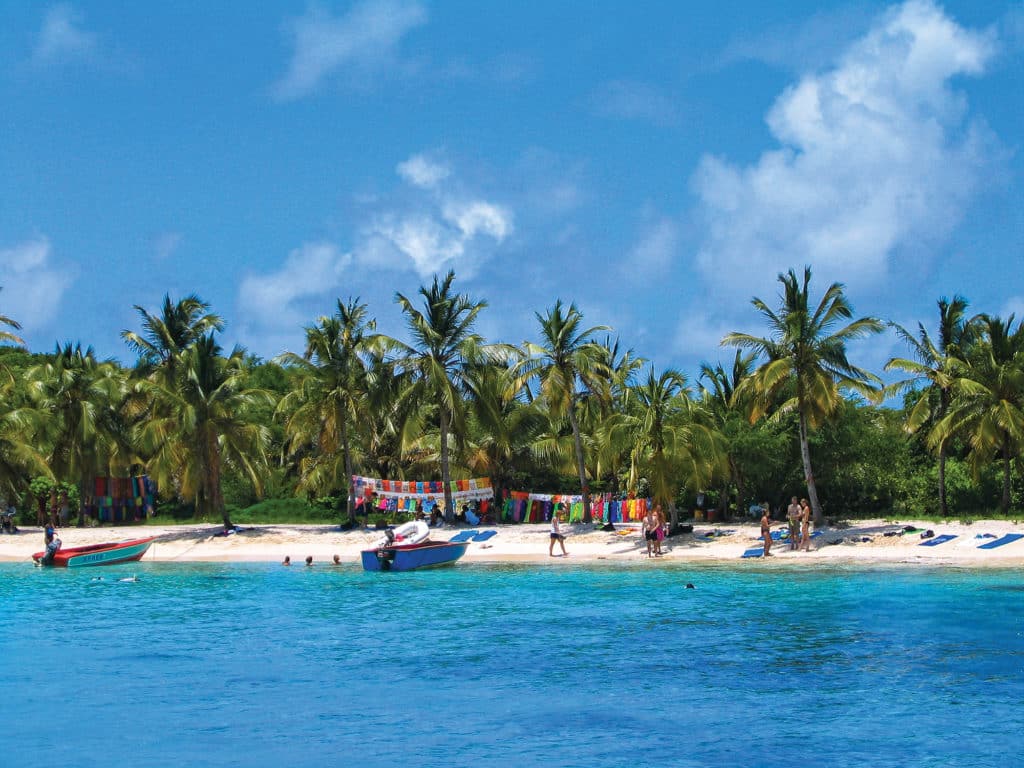
Union Island, the Grenadines
Larry and Justine spent the first 10 months of the pandemic lockdown in the Grenadines, a string of small islands that includes Bequia, Mustique, Canouan, Mayreau, Union and the Tobago Cays. It was early April 2020 when they arrived at Union Island—the last yacht allowed into the territory.
“We anchored in Chatham Bay for months and months,” Larry told me. “It’s on the west side of Union, and like Cumberland, it’s the real Caribbean. There are no stores, just a dirt road leading over the hill to town. There are a few cottages for the fishermen who live there, and in good times, a couple of fish shacks serve up barbecued fish, chicken and lobster.”
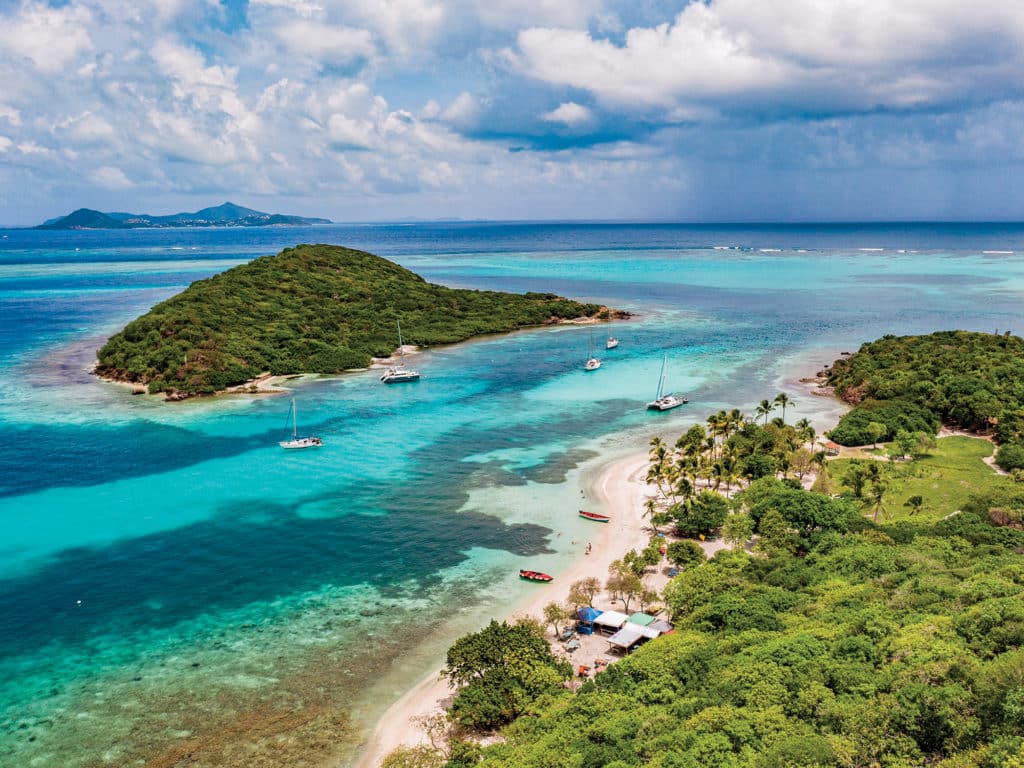
“The fishermen came by every few days to sell us tuna, red snapper, lobsters,” Justine continued. “Ashore, there are hiking trails, the snorkeling is good, the water clear and clean. We got to know a fisherman and his wife who live on the beach. Larry helped them wire up a solar cell so they could charge their cellphone. There’s no electricity there! They invited us to spend Christmas with them, which we did.”
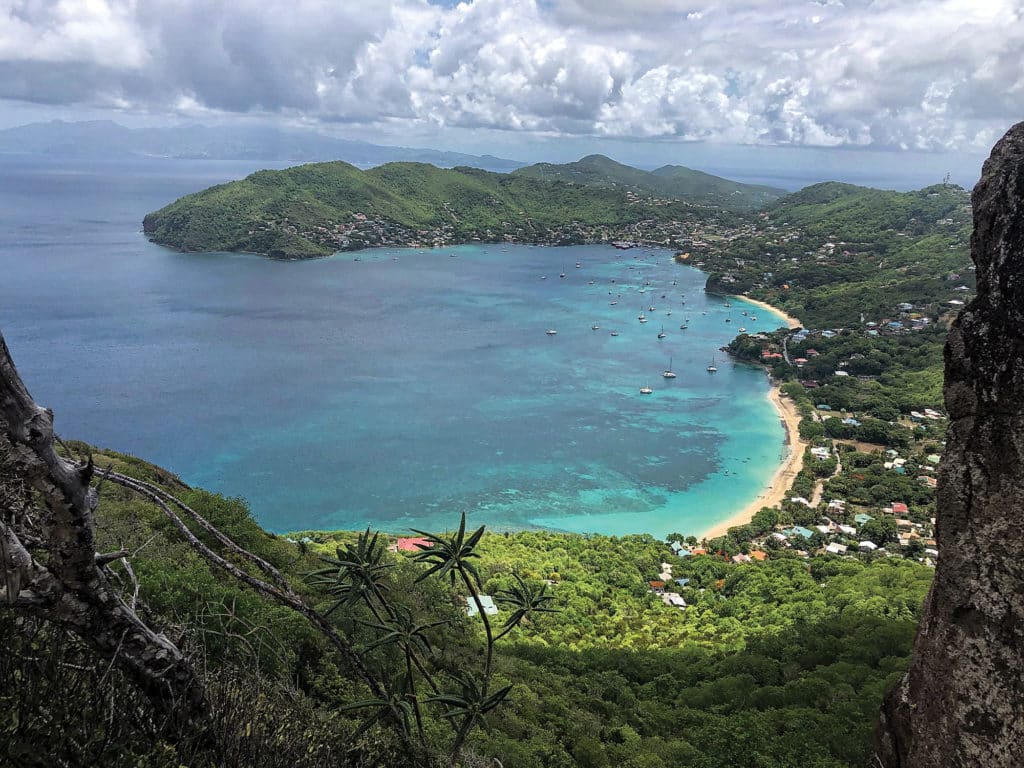
Bequia Island and Port Elizabeth
The Dove and two dozen other liveaboard yachts made Bequia home for much of the pandemic year. The harbor of Port Elizabeth and its small town had everything they needed: stores, an open fish and produce market, a chandlery, plus a few restaurants. They hiked the island, explored the beaches, snorkeled on the reefs, and worked on the boat. “The people were very happy to see us,” Justine said. “There was a potluck dinner somewhere each week for the cruising community.”
So there’s our shared list, which begs yet another question: Which is the best? It’s hard for me to choose a favorite Caribbean anchorage. I like them all, each for a different reason: shopping, snorkeling, hiking trails, waterfalls, and either the solitude or the shoreside community. It’s the “going back” to see each again that I like and appreciate. It’s like a good book, painting or photograph—you see so much more on each repeated visit. It might not be the island that has changed; maybe it’s me.
The important things are these: The deep blue Caribbean Sea spreads out before the bow; the mast and mainsail tower into a blue sky above; the green mountains of the next island rise up from the horizon. I’m back in the Caribbean, and that’s what matters.
David H. Lyman is a professional photographer, author and frequent contributor to CW. For more on Larry and Justine, and their travels on The Dove, visit their website, thedove88.com.
Planning Your Caribbean Escape
As vaccinations ramp up, more and more islands will hopefully be open to accepting guests, those arriving on planes and by yacht. Now is the time to begin researching your options, be it on your own boat, chartering a bareboat, or on a crewed charter yacht with a skipper and chef.
The eastern Caribbean has hundreds of islands in a 500-nautical- mile arc, from the Virgin Islands down to Grenada. It is possible, even desirable, to explore the entire eastern Caribbean in a single winter season; but then again, you could stretch it into a lifetime. After all, you’ll want to linger in each anchorage for a week or two, even a month. A one-week charter might include an island or two, and you can do the BVI in two weeks. But the last thing you want to do down there is rush around. Here are what I consider eight groups of islands, each worth a full two weeks of exploration:
- The Virgin Islands: US and British
- Anguilla, St. Martin and St. Barts
- Antigua: with 365 beaches and two dozen anchorages
- The big French islands of Guadeloupe and Martinique
- Dominica: Ashore is worth a few days
- St. Lucia and St. Vincent
- The Grenadines: Bequia down to Union Island, including the Tobago Cays
- Grenada and Carriacou
You can go anytime, but the best weather is late fall and late winter into spring, when the weather is more settled and the bareboat charter rates come down. To begin planning, you’ll need Chris Doyle’s cruising guides to the Windward and Leeward islands (doyleguides.com). Doyle updates his guides yearly with detailed information on shoreside amenities, hikes, shops and services.
In the old days, before Doyle and the internet, there was legendary Caribbean cruiser Don Street’s Cruising Guide to the Lesser Antilles. You can still find used copies online. My copy is from 2000, but as Street would say, “The rocks are still in the same place.” Street’s guide is for serious sailors and navigators, and includes compass bearings on approaches to all anchorages (remember, this was before GPS and chart plotters). If you are looking for secluded anchorages, Street has them, but they are often difficult to enter. Street, now in his 90s, is still racing sailboats in Ireland. His website is full of good stories and advice (street-iolaire.com).
Finally, download the Navionics app, then download the individual charts for the entire island chain (navionics.com). This app provides three valuable tools: You can zoom in and view detailed charts of each anchorage; there are notes and recommendations from ActiveCaptain cruisers who have been there and have the latest updates; and the app has a tool to measure distances between waypoints, and to estimate course and distance for route planning.








